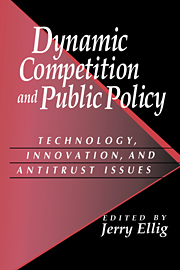Book contents
- Frontmatter
- Contents
- List of Figures and Tables
- Acknowledgments
- List of Contributors
- Introduction
- 1 A Taxonomy of Dynamic Competition Theories
- 2 Competence Explanations of Economic Profits in Strategic Management: Some Policy Implications
- 3 Innovation and Antitrust Enforcement
- 4 New Indicia for Antitrust Analysis in Markets Experiencing Rapid Innovation
- 5 Innovation and Monopoly Leveraging
- 6 Network Effects and the Microsoft Case
- 7 Technological Standards, Innovation, and Essential Facilities: Toward a Schumpeterian Post-Chicago Approach
- 8 Intellectual Property and Antitrust Limitations on Contract
- 9 Conclusion
- Index
Introduction
Published online by Cambridge University Press: 05 June 2012
- Frontmatter
- Contents
- List of Figures and Tables
- Acknowledgments
- List of Contributors
- Introduction
- 1 A Taxonomy of Dynamic Competition Theories
- 2 Competence Explanations of Economic Profits in Strategic Management: Some Policy Implications
- 3 Innovation and Antitrust Enforcement
- 4 New Indicia for Antitrust Analysis in Markets Experiencing Rapid Innovation
- 5 Innovation and Monopoly Leveraging
- 6 Network Effects and the Microsoft Case
- 7 Technological Standards, Innovation, and Essential Facilities: Toward a Schumpeterian Post-Chicago Approach
- 8 Intellectual Property and Antitrust Limitations on Contract
- 9 Conclusion
- Index
Summary
When sweeping economic change occurs, new technologies and business methods rapidly replace old ones. Previously unheard-of firms dominate their markets by successfully pioneering new ways of doing things. But a dominant firm also raises fears of monopoly. At what point does a successful competitor cross the line separating proconsumer innovation from anticonsumer monopolization?
During the past decade, scholars and government officials have asked that question more frequently as a “postindustrial” revolution, fueled by information technology and globalization, produces new winners and losers. Conceptually, the answer is simple and stated succinctly in U.S. antitrust law. A firm is engaged in monopolization if it employs “exclusionary” practices, but not if it dominates its market due to “superior skill, foresight, and industry,” or “as a consequence of a superior product, business acumen, or historical accident” (United States v. Alcoa, United States v. Grinnell). Congressional debate surrounding the Sherman Act reveals that the legislation's sponsors never intended antitrust enforcement to apply to a company that “merely by superior skill and intelligence get the whole business because nobody could do it as well” (Congressional Record 1890: 3146–52). This kind of distinction attempts to categorize firms with market power into those which succeed by harming consumers, and those which acquire their market power innocently through superior service to consumers or perhaps dumb luck. Surely, one would think, a highly innovative firm belongs in the second category.
- Type
- Chapter
- Information
- Dynamic Competition and Public PolicyTechnology, Innovation, and Antitrust Issues, pp. 1 - 15Publisher: Cambridge University PressPrint publication year: 2001
- 3
- Cited by

